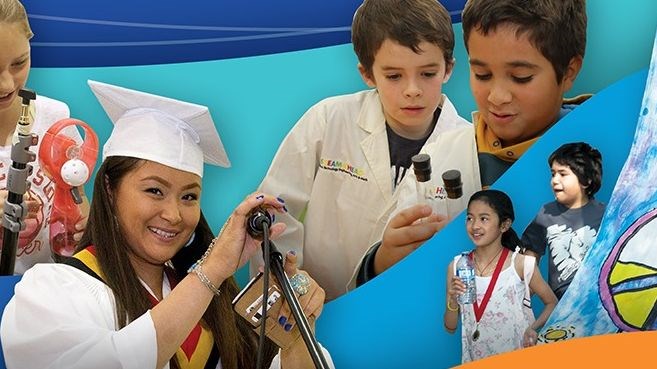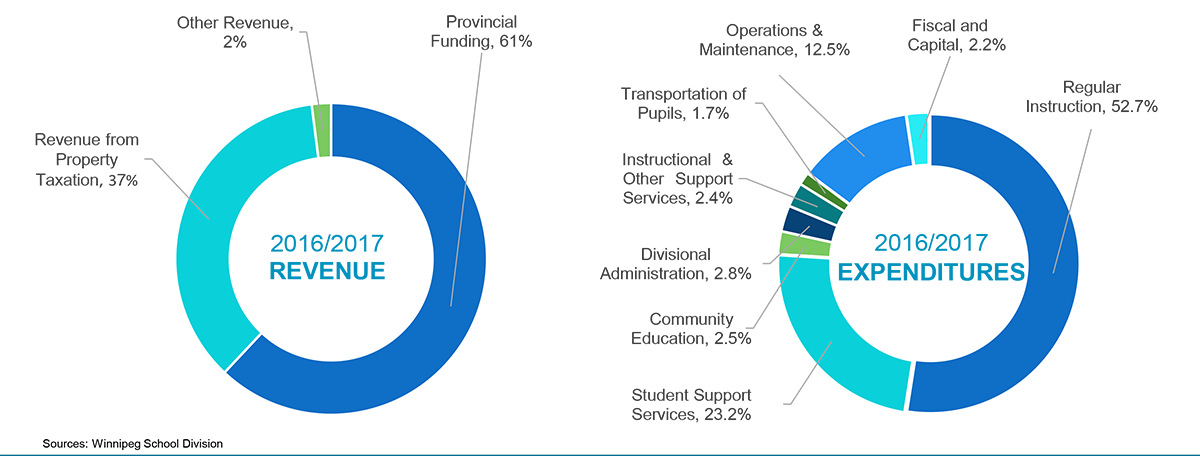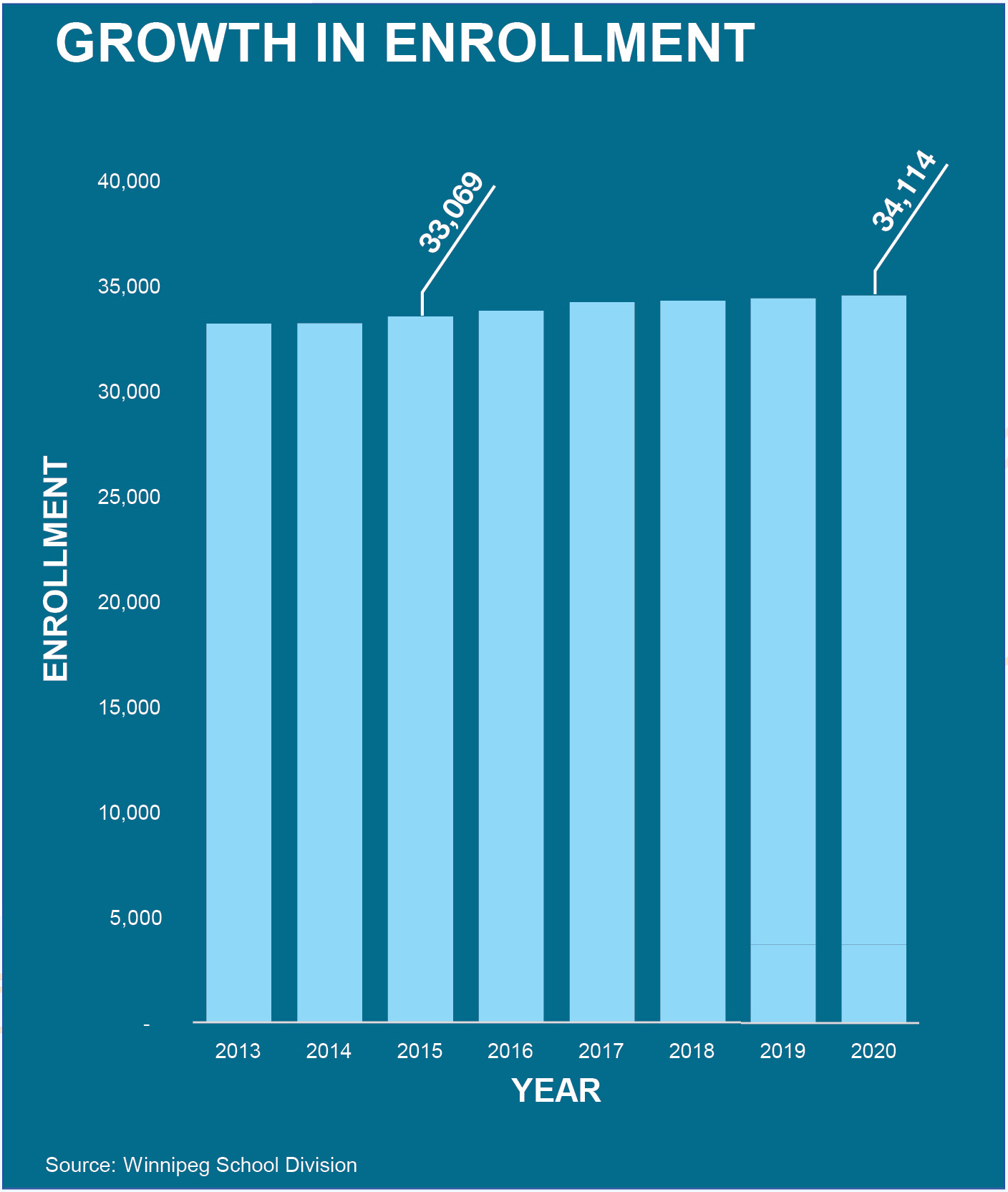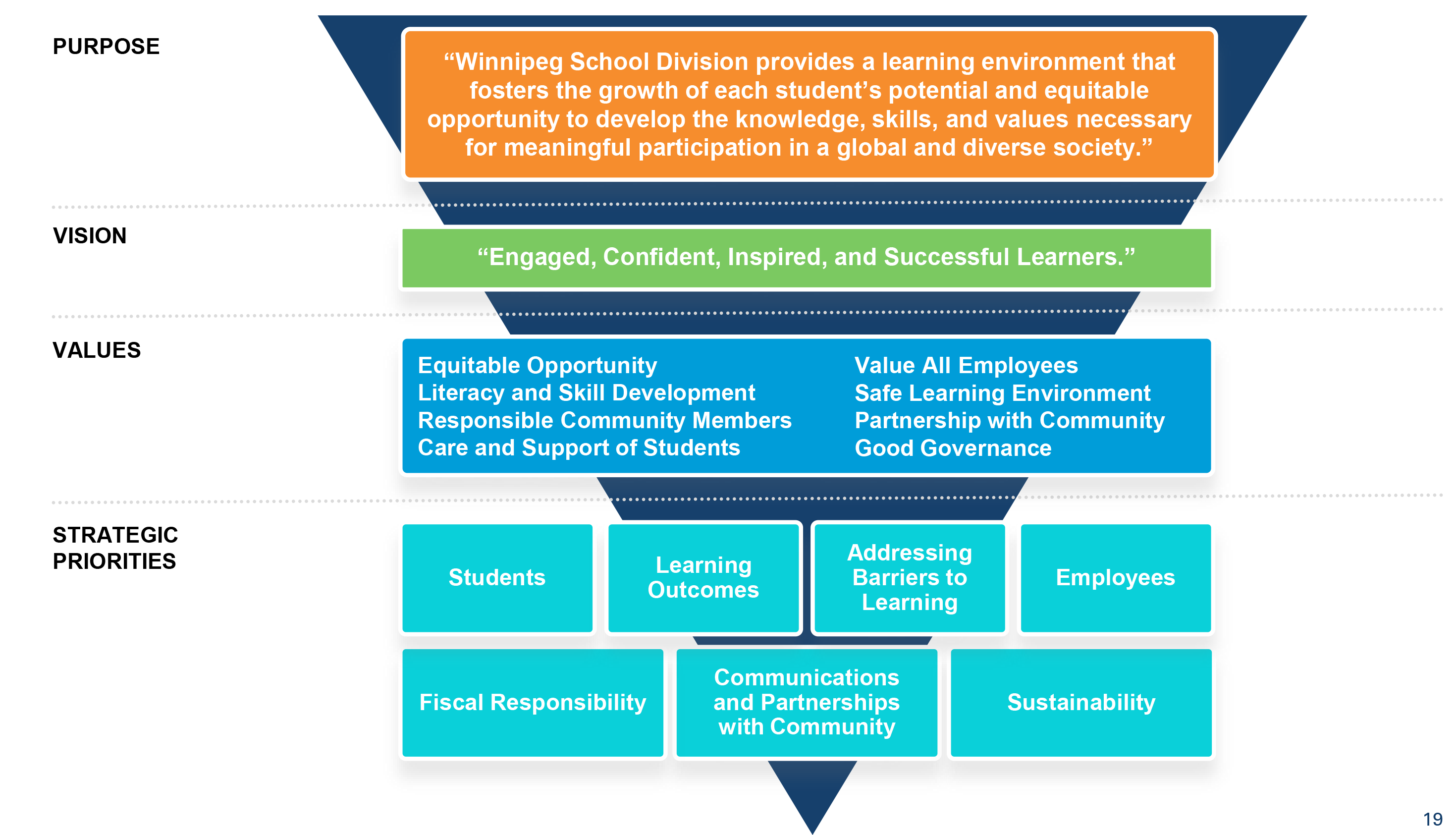Strategic Plan and report 2016-2022
May 1, 2023
Message from the Chair of the Board of Trustees and the Chief Superintendent / CEO
Established in 1871, Winnipeg School Division (WSD) is Manitoba’s first and largest school division in the Province.
Our Board of Trustees and Senior Administration worked closely together with focus and purpose to set out our strategic direction for the next four years. We listened to our community for input. As we go forward, WSD will continue to engage and communicate with our valued partners in our aspirations to see students and staff engaged, confident, inspired, and successful. Winnipeg School Division is on the educational forefront of inclusiveness, diversity, sustainability, innovation and partnerships, and being a progressive leader is fundamental to our school division in serving our community.
The Strategic Plan 2016 to 2020 outlines our strategic direction and priorities at a high level. Our Senior Administration is continually developing specific actions and tactical plans consistent with these strategic priorities.
Winnipeg School Division has many success stories of our students, leading examples of innovation and technology, and many amazing teachers, administrators, and staff dedicated to serving our children everyday. We invite you to get to know us better and work together in providing opportunities for all our students.
Mark Wasyliw
Chair (past), Board of Trustees
Pauline Clarke
Chief Superintendent / CEO
Purpose and Vision
Principles of Learning
Our Values
Equitable Opportunity – Believes in equitable opportunity, potential, and dignity of all individuals.
Literacy and Skill Development – Believes that in addition to basic literacy and communication skills all students must be challenged to develop the ability to collaborate, to create, and be critical thinkers.
Responsible Community Members – Believes each student must be given the opportunity to develop the values, attitudes, and principles that enable them to become responsible community members who relate to others in an ethical manner.
Care and Support of Students – Believes in advocating on behalf of students to ensure appropriate care and support services are provided for all children.
Value of All Employees – Believes its greatest resource is its people. The school division is committed to providing professional development for all employees and an opportunity to participate in the decision-making process.
Safe Learning Environment – Believes in the dignity of the individual and supports the staff in ensuring a safe, nurturing, and respectful learning environment within the schools.
Partnership with Community – Believes that the public school is an essential component of society and culture. By working cooperatively with the home and the community, the school division can ensure that its programs reflect the changing needs of society and the values, beliefs, and traditions of the local school community.
Governance – Believes in good governance, fiscal responsibility, environmental sustainability, accountability, and transparency.
Process
As part of on-going efforts to set direction for Winnipeg School Division (WSD), the Trustees and Senior Administration are committed to developing a strategic plan.
Following a request for proposals, KPMG was selected to guide and facilitate a process to develop a strategic plan for 2016 to 2020. The process was multi-faceted.
KPMG conducted research on WSD and leading North American public school districts; facilitated sessions with the Board of Trustees and WSD Senior Administration, and with local stakeholders and community members; and interviewed leaders in business, labour, educational and community organizations. Collectively, we worked to build consensus on strategic direction for Winnipeg School Division.
In the fall of 2015, KPMG conducted research, reviewed WSD documentation, examined leading practices in school districts in other jurisdictions, and conducted an environmental scan to provide context.
In January 2016, the first strategic planning session was held with the Board of Trustees and Senior Administration. In March 2016, interviews were held with leaders in the community. In April 2016, a community consultation session was held at Tec Voc High School.
On April 30, a second strategic planning session was held with Trustees and Senior Administration, reporting community input and to further develop strategies. In addition to these events, Trustees and Senior Administration receive ongoing input through budget consultations and informal meetings with the community.
Considerable work was done in formulating WSD’s new Strategic Plan. The process continues. We will continue to work to develop plans and implement actions aligned with the direction set out in WSD’s new Strategic Plan, and continue to communicate and partner with our community.
Context Overview
Winnipeg School Division
As Winnipeg’s most culturally and socio-economically diverse division, Winnipeg School Division (WSD) has a leading role in education in the City of Winnipeg and the Province of Manitoba. WSD has 77 schools and has the highest student population in Winnipeg, with more than 33,000 students from Nursery through Grade 12.
Fiscal 2016/2017 Budget
For the fiscal year 2016/2017, Winnipeg School Division set out a total budget of $396 million. Provincial government funding represents approximately 61% of the required funding, while property taxes and other sources represent approximately 37% and 2% of that funding, respectively.
The main expenditure categories for fiscal year 2016/2017 are Instruction, which represented 52.7% of all expenditures, followed by Student Support Services (23.2%), and Operations and Maintenance (12.5%).
The school division has a total staff complement of nearly 6,000.
Context Financial Overview

| Total number of schools: 78 Total number of students: 33,048 Number of graduates: 2,032 Students in language programs: 4,449 Students identifying English as an Additional Language: 6,501 |
Context Demographic and Economic

Demographic Trends:
Growth in enrollment in WSD is expected to increase through 2020 to over 34,000 students.
Economic Trends:
The Winnipeg region has experienced modest economic growth in recent years, and moderate growth is forecast to continue over the next four years. Population growth is expected to grow close to 1.3% annually and real GDP growth is expected to average close to 2% annually, with modest job growth and relatively low unemployment rates around 5.5%.
Immigration:
Nearly one-quarter of WSD students living with their parents are immigrants.
English and another language are spoken in the homes of 37% of students.
Indigenous:
WSD has the highest percentage of Indigenous students in Winnipeg, representing over 23% of students.
Income:
Incidence of low income ranged from 3% to 57% among neighbourhoods in the school division. There were 17 schools with an income below $40,000 (31% of schools) or/and there were 24 schools with income below $50,000 (44% of schools).
Context Environmental Infuences
Educational trends
Today’s students will graduate into a world requiring new competencies to succeed in a knowledge economy.
This will require:
- Math and Literacy.
- STEM (Science, Technology, Engineering, and Math) competencies.
- Problem-solving skills.
- New social/emotional competencies and cultural awareness.
Civic trends/context
Winnipeg schools operate in a city that has:
- Significant multi-cultural activity.
- A stable, diverse economy encompassing a broad spectrum of industries – e.g., aerospace, finance, insurance, education, healthcare, manufacturing, agribusiness, mining, construction, hydroelectric power, transportation, distribution, retail, business services, and government.
- Relatively low unemployment.
- Moderate socio-economic disparity.
Social/technological/economic/environmental trends
- Expectations of taxpayers/parents that schools, school divisions, and departments of education provide quality education and communication with parents on priority issues.
- Increased requirement for technological learning and aptitude.
- Public pressure to operate sustainably and with fiscal responsibility.
- People expect educational organizations to operate with equity, address social issues, and to value cultural diversity.
- Indigenous education.
- Corporate social responsibility and environmental sustainability.
Strategic Framework for WSD
WSD’s Strategic Framework –its Purpose, Vision, Values, and Strategic Priorities –forms a cohesive framework to guide decision-making by WSD Trustees, administrators, teachers, and staff.

Strategic Priorities
Students
To provide robust and comprehensive education, equitable access, diverse opportunity, and a supportive learning environment for all students to help them prepare for their journey with values of learning and social justice, and to be responsible community members.
Strategies
- Ensuring a positive learning environment through: policies that respect the intrinsic value of each student with an underpinning of social justice, inclusiveness, and a safe environment; a robust and challenging curriculum, well-trained staff, adequate technology and equitable access to learning opportunities; and provide students opportunities and educational means to develop their own skills, talents, and life plan.
- Providing a range of programs and resources to enable students to reach their full potential and continue new programming and creative initiatives to meet the needs of students in a very diverse community.
- Focusing on consistent approach and application of our Principles of Learning and develop student skills in literacy, math and science, problem solving, collaboration, critical thinking, and creative thinking.
- Continuously developing Indigenous education initiatives.
Key Performance Indicators
- Student achievement and performance locally,provincially, and nationally
- Satisfaction and well-being survey of students and parents
- Percentage of students at grade-level in literacy and math
Learning Outcomes
To further improve school attendance, achievements, and graduation rates through the exploration of additional programs and strategies.
Strategies
- Enhancing projects, initiatives, and enrichment programs to achieve and exceed grade level outcomes in literacy, math, and science.
- Maintaining and expanding projects and initiatives that demonstrate results in improving attendance and graduate rates.
- Supporting early childhood development initiatives and the development of further data and evidence on the importance of early childhood initiatives in educational outcomes.
- Supporting students in their transition and opportunities from high school to their next path such as post-secondary education, trades, and jobs.
Key Performance Indicators
- Percentage of students attending school 90% of the time
- High school graduation and course completion rates
Addressing Barriers to Learning
To further develop initiatives and innovative approaches addressing special needs and accessibility requirements, mental health issues, childcare needs, and nutritional needs.
Strategies
- Maintaining and defending the best learning environments, the learning continuum, Clinical Support Services, Interdivisional Student Services, and other initiatives.
- Addressing nutrition for vulnerable students as a basic human need, which includes maintaining and expanding nutrition programs.
- Improving academic and behavioural support services for students with special needs.
- Enhancing partnerships with healthcare and other organizations to address mental health concerns, provide mental health education to staff and students, and to build on programming created to improve awareness and address mental health.
- Continuing the phase-in of capital projects to ensure all facilities are physically accessible.
Key Performance Indicators
- Programs/initiatives to address accessibility, equity andsocial well-being
- Stability and mobility of children and families
Employees
To retain, attract, and develop our valued staff who are dedicated to the vision, purpose, values, and Principles of Learning of Winnipeg School Division, and reflect community diversity.
Strategies
- Hiring a workforce that is representative of ourcommunity.
- Continuing to improve upon hiring and retentionpractices to ensure WSD is providing the most qualifiedemployees to our students.
- Continuing to provide high quality support andprofessional development for our staff to foster theircreativity, and to be on the cutting edge of education.
- Further building partnerships with the universities andcolleges to develop staff within the Indigenouscommunity, internationally trained teachers, and leadingprograms in special education and math.
- Continuing to increase the leadership capacity andcompetency within schools.
- Ensuring effective communications internally andexternally, understanding that staff are WSDambassadors, and the face of WSD in the community.
Key Performance Indicators
- Rate of employee retention/turnover (%)
- Diversity of school division staff –Equity Report(employee self-declaration)
- A comprehensive Employee Engagement Strategy bedeveloped
- Promote leadership opportunities
Fiscal Responsibility
To provide responsible management of tax dollars and resources to ensure long-term fiscal sustainability and accountability of the programs, facilities, and services that we provide.
Strategies
- Ensuring good governance, accountability, andtransparency in the reporting of finances and operations,including annual budgets and consultation, annualreports, and audited financial statements that arepublically available.
- Implementing the long-term capital plan, and recognizingand prioritizing needs and plans for infrastructurerenewal, including further development andimplementation of the technology infrastructure plan.
- Continuing to prudently manage expenditures, effectivelyallocate resources, and diligently seek operationalefficiencies across the school division.
- Continuing to prudently manage the long-termsustainability of WSD pension funds.
- Pursuing additional sources of funding for programs,including attracting additional revenues for the Children’sHeritage Fund, expanding upon scholarship programs,and developing partnerships with other communitystakeholders.
- Advocating on behalf of students and ratepayers togovernment for sustainable funding.
Key Performance Indicators
- Financial plans and results (annual budgets, annual reports, and auditedfinancial statements)
- Cost savings achieved in current year
- Budget-to-actual expenses (% variance)
- Percentage of funding allocated directly to schools compared to division administration
Communications and Partnerships with Community
To further develop communications and partnerships with the communities we serve, parents, families, government, businesses, health and social service agencies, Indigenous education, other community organizations, and our valued volunteers.
Strategies
- Continuing to engage parents, guardians, families, andcaregivers as critical partners in learning.
- Pursuing partnerships and activities in the communitythat raise awareness and advocate for student needs.Communicate successes to the community.
- Developing initiatives to expand the use of communitypartnerships, connecting with WSD graduates in localbusiness and industry, encouraging graduates to liveand work in Manitoba, utilizing in-house expertise,apprenticeships, co-op programs, and partnerships torespond to labour market needs.
- Continuously developing Indigenous Educationinitiatives. Demonstrate leadership in acting on therecommendations of the Truth and ReconciliationCommission where applicable for a public schooldivision.
- Developing school community hub programs withwrap-around services for children and families asappropriate. Continue to identify applicable healthand social service supports.
Key Performance Indicators
- Number of partnerships developed that support the objectives of thestrategic plan
- Number of student placements for career and life skill development
- Staff providing volunteer hours in the community and number ofvolunteers working in the school division
- Number of joint services with community organizations
Sustainability
To strengthen and enhance sustainable development initiatives that address environmental, social, and economic issues.
Strategies
- Implementing the Education for Sustainable Development plan, through the five lenses of: governance, curriculum, teaching and learning, capacity building, facilities and operations, places emphasis on citizenship and environmental stewardship behaviors.
- Developing initiatives that are reflective of the interdependence of economic, environmental and social issues such as waste reduction, energy management, LEED (Leadership in Energy and Environmental Design) implementation, and human rights.
- Continuing to expand diversity and equity related practices in education.
- Expanding active transportation initiatives such as cycling, walking school bus, and encouraging physical activity as part of the learning experience.
Key Performance Indicators
- Carbon footprint of WSD operations
- Water and energy consumption, volume of recycling
- Programs and initiatives that address the Education for SustainableDevelopment plan through the five lenses of sustainability
- Use of low emitting materials in all operations
